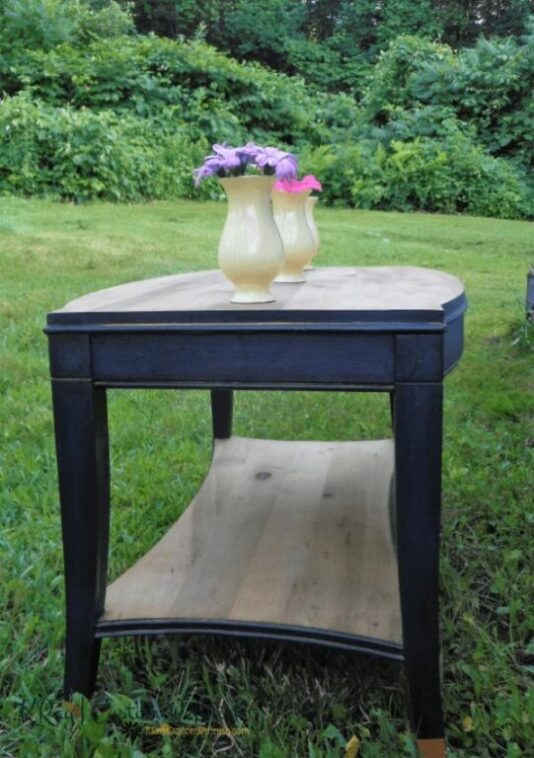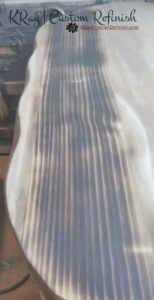**Heads up: This post contains affiliate links. As an Amazon Associate, I earn from qualifying purchases. Meaning I may receive a small commission– at no cost to you, of course– were you to make a purchase through any of the links. If I link to a product, I use it, I love it, and I think you would too! Please see my Privacy Policy for more details.**
Did you know that hardwood furniture doesn’t always have to be stained or painted to change the way it looks or “finish” it?
A lot of people don’t.
There are tons of other wood finishing techniques besides stain, and today I will be discussing 5 of them.
I began this post with a plan to write about “Distressing Techniques” for wood furniture. Other than the standard paint distressing techniques I spoke about in my last post, of course.
But really, these aren’t necessarily “distressing” techniques. They’re more “finishing techniques” for wood furniture. Let me list the techniques I’ll be discussing so you’ll understand where we’re at here:
5 Wood Finishing Techniques For Furniture Other Than Wood Stain
These techniques are hard to describe, but they are basically out-of-the-box techniques, for creating a different finish on wood furniture. Maybe you’ve heard of all of them, maybe a couple, maybe none. But I love using them all, so I figured I’d share how to use each; should you ever choose to try one.
What’s the first thing you should do before refinishing a piece of wood furniture?
Figure out the wood type.
Different woods require different methods for sanding, staining, painting, repairing, you name it.
After hours on Google comparing photos of hundreds of wood grains to your piece, are you more unsure than ever? Get the 169 page interactive eBook, “Grain”.
Staining Wood With Paint/Color Washing
This technique is “technically” stain. But you’re going to use regular acrylic paint.
There are a couple of different methods for staining with paint:
Method 1 – Add water to the paint. Usually 50/50. Then apply it to the wood with a paintbrush.
The ratio to paint would be about 2:1. So the amount of paint you want to use, mix in about half that amount in water.
Then apply it to the wood with a foam brush or sponge. Wipe the excess after a few minutes; before the paint begins to dry.
Method 2 – Use straight paint, with a lint-free cloth. Wipe it onto the wood lightly, let it absorb into the wood and then wipe off the excess. Just like you would with wood stain.
“Washing” the paint in water, usually leaves a more even finish. You won’t get a splotchy, uneven finish with this route.
Then again, I find that if you use straight paint instead of watering it down, the color is much more vibrant, and the wood grain usually shows up nicer.
There’s a slight chance of uneven absorption with this method, however, so make sure you sand the wood properly. You should also pre-treat the wood just as you would with regular wood stain. After lots of experimenting my go-to for pre-treatment before a wood stain is the Black Tea Method.

The Best Coloring and Wood Grain Come When The Paint is Used Without Water Added
It’s definitely a great technique for a piece that you want a little bit of color on but still love to show off that wood grain we all love so much!
Natural Oil Finish Technique
When I started writing this I had Coconut Oil as its own technique. But as I researched I found that really there are multiple oils that you can use on wood for very similar results to coconut oil. (Honestly a lot better than coconut oil.)
There are a few different Oils you can use: Tung Oil, Danish Oil, Linseed Oil, Teak Oil, and Coconut Oil. A lot depends on what type of wood you are finishing, and your budget.
Not sure what type of wood your piece is? The Ultimate Guide to Wood Identification in Furniture should solve that problem for you!
Danish Oil and Coconut Oil don’t completely seal the wood, so you will need to reapply it overtime to keep the nice finish. Tung Oil, Linseed Oil, and Teak Oil all penetrate the wood deeply and completely seal the finish. They are more on the pricey side so that’s something to think about.
Oils Can Be Used Over an Existing Finish, or on Bare Wood
You don’t have to completely remove the existing finish when using the oil technique. If you’re just looking for a quick refresh of your piece, oils work perfectly.
Just lightly sand the piece to remove any dirt on the surface, and apply the oil right over the finish. Penetrating oils will still penetrate the wood easily.

Oils Enhance The Wood Grain And Color
After applying oils to your wood piece, you’ll see a beautiful transformation. If you love the natural wood look it’s definitely the way to go.
Some oils have more of a matte finish, and some finish glossy. Either way, the wood grain, and color are greatly enhanced, without changing the wood whatsoever.
You can feel confident you’re seeing the 100 percent natural wood color if you use the oil technique.

Vinegar & Steel Wool Technique
I did a short tutorial for this technique in another post, but I thought I’d go a little more in-depth on this one. It’s definitely a technique I use a lot, it saves money and the color it adds to the wood is phenomenal.
This May Be Considered “Staining” As Well, But a Unique Technique Nonetheless
Materials Needed:
Small Bottle White distilled Vinegar
Plastic Container To Mix
Depending on the size project you’re working on, a small bottle of vinegar with about 4 or 5 steel wool pieces should work great. You don’t need a ton of the liquid to stain your wood.
Empty the vinegar into a large plastic bowl, or container with a lid preferably. I like to use empty Folger’s Coffee containers. They’re basically coffee cans made out of plastic. (Perfect for lots of household uses!)
Throw your steel wool in; as I said, usually 4 or 5 will do the trick. I have done it with fewer, it didn’t come out quite as dark. So you may want to experiment a bit with this on your own.
There are actually a few variables that will give you a darker stain with this method:
- The more steel wool you add to the mixture, the darker the stain.
- The longer you let the mixture sit in the container, the darker the stain.
- And lastly, the longer you let the mixture sit on the wood, the darker the stain.
Normally, I let the mixture sit overnight in the container before applying it to the wood.
Use one of the pieces of steel wool to apply the vinegar mix to the wood.
Squeeze the excess vinegar out of the wool piece, and then rub it along the face of the wood, with the wood grain.
If you don’t want a very dark stain, wipe the excess off immediately. Otherwise, leave it for a minute or so, then wipe it. You can leave it on for up to 15 minutes before wiping the excess, very similar to a wood stain.
The Darkness You Can Get From This Treatment Far Surpasses Regular Stains In My Opinion
Honestly, the pieces I’ve done and left the mixture on for 15 minutes, were basically black by the time I removed the excess.
So I wouldn’t recommend leaving it for that long. It also depends a lot on what type of wood the piece you’re working on is made of.
If the wood your using easily accepts stain, it will most likely turn a darker color than other wood types.



But if you’re looking for a unique-looking “wood stain”, vinegar and steel wool is definitely a great choice!
Natural Wax Finish
Using wax on bare natural wood can give you a couple of different style looks for your piece. There are a bunch of different finishing wax options. My favorite waxes are MudPaint’s Finishing Waxes which come in black, white, dark, and even metallic!
After sanding down your piece completely to where you are satisfied with it as your end result, you can begin applying your wax.
I normally clean the wood beforehand by wiping it down with mineral spirits and a clean rag. Wait for the mineral spirits to evaporate fully, and then you can begin applying your wax.
You Can Use Clear Wax Before or After Dark Wax For 2 Very Different Looks
Dark wax is slightly difficult to work with when used alone. It may absorb quickly into the wood, and cause uneven areas or splotches. Your best bet is to coat the piece entirely with clear wax. Then go over it on certain areas with the dark wax to create an aged look.
You can also create an antique wax glaze as I did in my Antique Wax Chalk Paint Tutorial. Mix your antique wax 50/50 with mineral spirits to create the glaze, and then coat the wood with it. It’s a lot easier to work with when made into a glaze.
Wax is a great alternative to oils or polyurethane finishes
I find that the end result after using wax is a lot more subdued than with oil or other topcoats. It usually has a matte finish that goes perfectly with the natural, rustic, or farmhouse look.

Wood Burning Technique
Wood burning is another very out-of-the-box technique that takes some serious practice.
Disclaimer: I am not a wood-burning professional. Please do your research, and if need be, consult a professional before attempting any of the wood-burning techniques I discuss below.
Yes You Will Be Setting The Piece On Fire – If This Doesn’t Sound Fun For You, Skip This Technique
I’ve seen wood burning done in several different ways. I personally find the Shou Sugi Ban Wood Burning Technique to be the most beautiful. So I try to use a similar technique. It is an ancient Japanese technique originally for waterproofing and preserving wood.
It was meant only to be done on cedarwood, but can be done on many other wood types as well. You won’t get quite as dramatic an effect as with the cedar, but I still think it’s gorgeous on furniture.
How to Attempt the Wood Burning Technique on Furniture
Using a torch similar to this one:

- Hold the flame close to the wood piece, and slowly move back and forth across the piece, working your way down over the entire area of the wood. Move downward with the grain of the wood, but move slowly from side to side.
- Once you have your area completely blackened, use a wire brush moving straight up and down the grain, to scrape off the ash and char from the wood.
- Wipe or blow off all of the dust with a clean cloth or air compressor.
- Then take your sander with 220 grit sandpaper and sand down the wood to smooth. There will be cracks and crevices from the steel brush sand all of those down to smooth.
- Then apply your choice of sealing topcoat.




Your Result Will Be Unlike Any Other Possible Finish You Can Attempt.
I was personally amazed the first time I tried this technique. It truly transforms the wood and brings out every little neat characteristic of the grain in a way much different than just plain old wood stain does!

So those are the 5…
Having These 5 Techniques Down Will Truly Add To Your Skill Set In Becoming Great At Refinish Work
It’s always good to have some tricks up your sleeve when it comes to wood furniture finish work. Every piece is different and every customer is as well. Have you ever tried a super out-of-the-box technique? I’d love to hear about it!
If you master these 5 special techniques for finishing wood furniture, you’ll be on your way to becoming a master refinisher!
If you need help on more basic finish work, check out my posts Game-Changing Tips on Sanding Wood Furniture, or How to Stain Wood.
And before you get started on your next project, make sure you download my free printable project planner pages! Keep all of your projects organized and become an efficient refinishing machine 🙂

Until Next Time,
KRay




That wood burning method is really neat. I would like to try that on a project! This was very informative!
Wow! I really want to try that wood burning method. It looks really awesome, and bonus: getting to play with fire? Yes, please!
Right?? So much fun! Let me know how it goes if you try it!